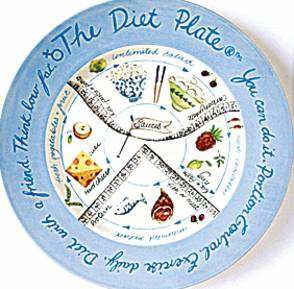Dishing out portion control
Published 5:00 am Thursday, July 19, 2007

- The following products can be found at www.thedietplate.us/: The Diet Plate, above, (male, female versions): $35 The Magic Plate (kids version): $35 Calorie-controlled breakfast bowl, above: $29
A new wave of dinnerware, like The Portion Plate seen below, helps adults and kids manage their portion sizes. This plate is available at www.theportionplate.com for $11.95. See other portion-managing plates on Page E10.
In the battle of the bulge, plates and bowls are generally passive observers, allowing individuals to heap on as much food as they want. Now a new generation of dinnerware is taking on the role of dietary adviser, providing consumers direction on appropriate portion sizes to keep calories under control.
Trending
Portion sizes have consistently grown in size over the past 30 to 40 years, both at restaurants and at home. And numerous studies have shown that the number of calories people consume is directly related to the serving size offered. Nutritionists often urge clients to use measuring cups and other tools to ensure portion sizes meet recommended levels, but many individuals balk at the hassle of measuring out servings.
To make life for clients simpler, dietitians have put the dietary advice and measuring tools directly on the plate. Most of the plates use the same general strategy: half the plate should be filled with fruits and vegetables, a quarter with whole grains and the remaining quarter with lean protein.
The Portion Plate, sold by Be Better Networks, adds visual clues to help consumers identify appropriate portions of meat and beans, whole grains and fruits and vegetables.
For example, the plate pictures a deck of cards for a serving of meat and a computer mouse for a serving of vegetables. A kids version of the plate uses a box of crayons for the meat serving and a compact disk for the serving of grains.
While it may seem like a gimmick, a recent Canadian study from the University of Calgary demonstrated the portion-control plates can be an effective weight-loss aid. Researchers recruited 130 people with type 2 diabetes and a body mass index of at least 30, and instructed half of them on the use of a portion-control plate and bowl.
The intervention group received a calibrated dinner plate and cereal bowl manufactured in England. The plate comes in a male version, calibrated for an 800-calorie meal, and a female version calibrated for a 650-calorie meal. The plate delineates limits on serving sizes of carbohydrates, proteins, cheese and sauces, while allowing the remainder of the plate to be filled with vegetables. (The Diet Plate manufacturer also offers a Magic Plate, with Harry Potter-themed images, including wizards and owls.)
Trending
The bowl used in the study has different colored rings inside. The bowl comes with a list of popular cereals showing which color rings corresponds to 200 calories of that cereal with 1/2 cup of milk.
The intervention group was instructed to use the plate for their biggest meal of the day and the bowl when they ate cereal for breakfast. They were also told not to increase other meals to make up for the portion control.
The control group received standard dietary counseling from a nutritionist, but no portion-control tools.
After six months, 11 of the 65 people using the plates lost at least 5 percent of their initial body weight, compared with only three of the 65 people in the control group.
Helping diabetics
Researchers noted that a 5 percent loss in body weight has been shown to have significant benefits in decreasing complications from obesity-linked disorders such as diabetes or heart disease.
“My study shows that this portion-control tool is an effective way for diabetics to lose weight, which is encouraging since diabetics tend to have a very difficult time with weight control,” says Dr. Sue Pedersen, an endocrinologist at the University of Calgary and the lead author of the study. “The weight loss we saw is similar to studies using weight-loss medication, but without the potential side effects or the expense.”
Additionally, Pedersen found that 26 percent of those in the intervention group were able to decrease the use of their diabetic medication after using the plates, compared with 11 percent in the control group. Conversely, 34 percent of those in the control group had to increase their diabetes medication, compared with only 14 percent in the intervention group.
While the study included only diabetics, Pedersen says portion-control plates can help anybody trying to lose weight.
In a recent federally funded obesity study that compared five weight-loss strategies — eating less fat, eating more produce, increasing activity, increasing planned exercise or controlling portion size — portion control led to the most weight loss.
The EZ Weight Plate, developed by Laurie Acosta, a registered dietitian and a diabetes educator in New Orleans, takes the portion-plate concept one step further, building measuring cups directly into the plate.
“With diabetics we individualize their meal plans to be really specific. If you’re 5’2 and 150 pounds trying to lose weight, you’re going to be on 1,500 calories, so you’re going to measure your food differently than someone who’s 6’2,” Acosta says. “So we wanted something that was universal with measurements.”
A teaching tool
Acosta and a colleague searched the Internet but didn’t find a plate they liked, so they created their own. They started selling them locally to their own patients and have made the product available over the Internet since the start of the year.
“With portion control, you can eat a lot of things that you enjoy, things they tell us we can’t have. Sometimes we get fixed on that and we wind up overeating in the process,” Acosta says. “I live in south Louisiana, and we have the fried fish and fried shrimp, and I still let my patients have that every now and then, but I want them to measure it out.”
Allowing patients to include their favorite foods in moderate portions means they’re more likely to stick to the overall dietary advice, she says.
Acosta says some of her patients use the plate to measure out portions and then transfer the foods to a normal plate, but others eat directly out of the microwavable, dishwasher-safe plate. It even comes with a plastic cover allowing patients to easily transport a full plate to work.
“I tell them the plate is not a weight-loss gimmick. If you buy the plate, you’re not going to lose weight,” she says. “It’s a teaching tool to help you learn what your portions need to be because we’ve oversized everything.”
The various plates run in price from $12 to $35, not including shipping charges. For a lower-cost alternative, buy a plastic compartment plate divided into three sections at a camping store ($2 at REI). Use the largest section for fruits and vegetables, and the smaller sections for meat and whole grains.








